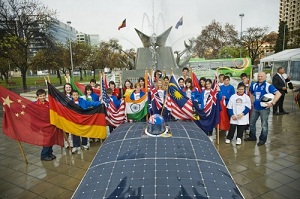First of 42 solar cars arrives in Australia for largest solar race to date
 On Sept. 6, the first of the international solar-powered cars, the Nuna 6 from the Netherlands, arrived in Darwin, Australia. The car is the first international car of the 42 entrants into the largest solar car race to date.
On Sept. 6, the first of the international solar-powered cars, the Nuna 6 from the Netherlands, arrived in Darwin, Australia. The car is the first international car of the 42 entrants into the largest solar car race to date.
“From past winners and rivals, Japan and The Netherlands, to the million dollar Michigan contingent and our own Aurora, NSW University and SA Tafe teams, to those first time competitors from India, Saudi Arabia, Iran, Turkey, Switzerland, Italy and Korea, this event promises David and Goliath contests at every checkpoint,” Mark Warren, South Australian Motor Sports Board CEO, said in a press release.
The 3,000 kilometer biennial race across Australia was first held in 1987 and has grown continually. In 2009, 32 teams entered, according to World Solar Challenge spokesperson Judi Lalor.
This year teams from 21 countries are participating.
“Every year the event attracts new competitors from new countries,” she said.
Over the years, as solar technologies and aerodynamics of the cars have advanced, race sponsors have adjusted how much solar the cars could have on them, their size and even how fast the cars can go (they now have to follow posted speed limits and incur time penalties when caught over the limit).
“Unique to the World Solar Challenge held in Australia is the focus on energy management,” said Lalor.
One of the requirements coming out of that focus is the amount of stored energy cars can have on board.
“Based on the original notion that a 1,000-watt car would complete the journey in 50 hours, solar cars are allowed a nominal 5-kilowatt hours of stored energy, which is 10 percent of that theoretical figure. All other energy must come from the sun or be recovered from the kinetic energy of the vehicle,” she said.
Even with that and other requirements, cars have been getting faster over the years.
“The organizers always plan for advancements in technology that may result in teams reaching Adelaide earlier then previous years. Teams used to arrive into Adelaide on Fridays, then Thursday, and it wouldn't be unreasonable that soon teams may start arriving late on Wednesday,” Lalor said.
So even though the world’s fastest solar cars, like the University of New South Wales Sunswift car, which currently holds the Guinness World Record for World’s Fastest Solar Powered Vehicle, there’s more to the race than that. And it may just come down to who’s built the most reliable car and assembled the best team.
Certainly the Nuna team is hoping to reclaim the title, which they won in three previous challenges.
Image courtesy of the World Solar Challenge.



